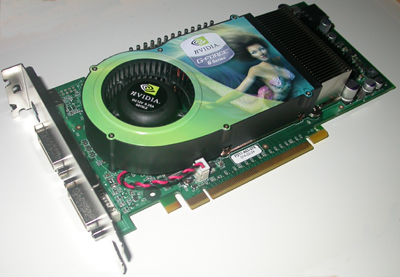Introduction
In our recent look at the new Intel 925X platform and PCI Express graphics, we bore witness to the final verdict on bridged vs. native performance. It is easy to see that both ATI and NVIDIA have a negligible difference when moving between PCIe and AGP under current DirectX and OpenGL games. Of course, we will take another look at the question when we get boards with both AGP and PCIe slots on them just to further seal the deal.But performance differences weren't the only complaint that opponents of non-native PCIe GPUs levied against NVIDIA. And after last year's struggle through NV3x, NVIDIA just can't afford to lose any battles. So, what are NVIDIA doing about it? We brought you the answer from Computex 2004: NV45.

NVIDIA's NV45 looks just like a PCIe 6800 Ultra.
In short, NV45 is NV40 with an on package PCIe to AGP bridge (which NVIDIA calls "HSI" or "High Speed Interconnect"). And just what do we get from this package integration? Let's find out, shall we.










14 Comments
View All Comments
kherman - Monday, June 28, 2004 - link
How did this get eh NV45 label? Shouldn't this be the NV40p or sum'n?Minotaar - Monday, June 28, 2004 - link
Pentium Pro did NOT have on-package cache. Pentium Pro had On-DIE cache. Pentium 2 took a step backwards and had on-package cache (that huge ugly slot garbage, with the triple fans from OC co's like Glacier? The side two fans cooled cache chips on the side). It wasnt until Socket P3 that on-die cache came back.Thats why celeron happened the way it did. it started off as a p2 with none of the on-package cache. Remember the ol' celly 266 that OC'd to 450, and for some lucky ones 504? Well That was just the P2 card without the cache on the sides - the sides were empty.
Pentium Pro also had the advantage of clock speed cache, whereas P2's cache was bus speed. But I digress. The article has an inconsistancy.
Brucmack - Monday, June 28, 2004 - link
Well, you're not going to gain anything in the near future with PCIe, so if you already have an AGP card, don't bother.It would probably be a good idea to get a PCIe card if you're upgrading to the new Intel chipset though. The boards that have both PCIe and AGP slots are running the AGP slot off of the PCI bus, so there will be a slight performance penalty associated with that.
GhandiInstinct - Monday, June 28, 2004 - link
So is AGP8x faster or better than PCIe, because that's what I got from those earlier benchmarks. Or will drivers and optimizations change that in the future?Basically, is it worth while(money) to purchase PCIe now?